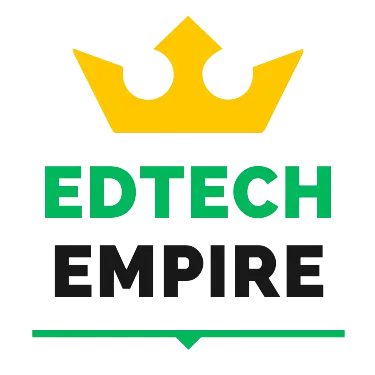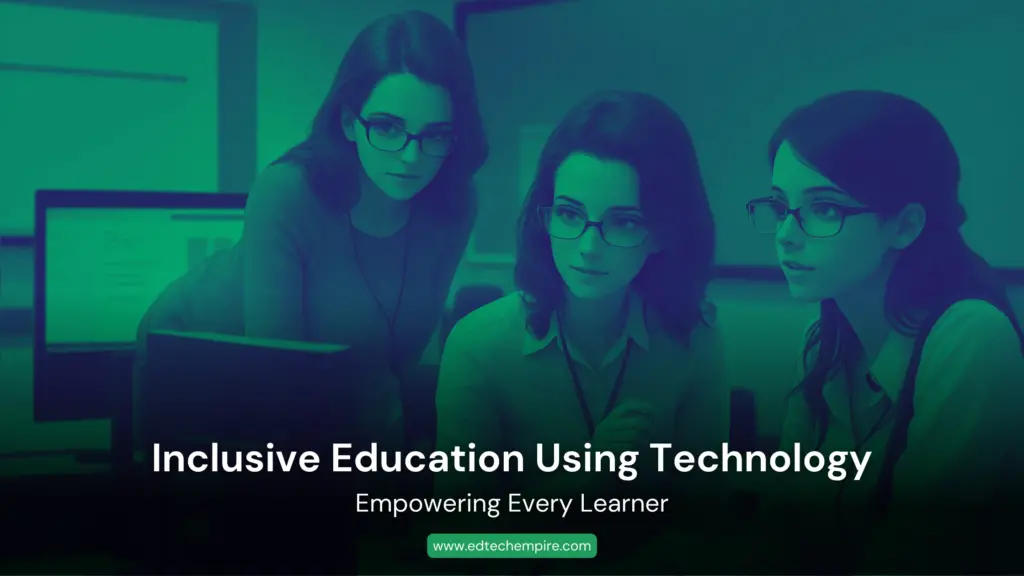![]()
Education, in a world that’s always changing, keeps evolving to meet the needs of diverse students. One transformative wave, inclusive education through technology, sweeps across the educational landscape. It changes how we see learning and, most importantly, how accessible learning becomes. This blog post explores the captivating and inclusive realm of educational technology, known as EdTech. It shows how it creates an environment where everyone, no matter their abilities or backgrounds, can learn and succeed and the ways teachers can enable inclusive education using technology.
Table of Contents
- The Concept of Inclusive Education
- The Role of Technology in Inclusive Education
- Overcoming Challenges to Implement Inclusive Education Using Technology
- FAQs on Inclusive Education Using Technology
- 1. What is the role of educators in implementing inclusive education using technology?
- 2. How can technology enhance learning for students with disabilities?
- 3. Are online learning platforms effective for inclusive education?
- 4. How do collaborative learning tools foster inclusivity?
- 5. What are the challenges in implementing inclusive education using technology?
- Conclusion
The Concept of Inclusive Education
Let’s start by understanding what inclusive education truly means before we delve into the role of technology in promoting it. Inclusive education is a philosophy that believes every student, regardless of their abilities, disabilities, or social, ethnic, linguistic, or cultural backgrounds, should have an equal chance to access, participate in, and benefit from education.
Inclusive education goes beyond granting physical access to classrooms for everyone. It involves transforming the culture, policies, and practices in schools to accommodate the learning needs of all students. It requires ensuring that teaching methods and educational resources can adapt and be flexible enough to meet the diverse requirements of each student. In essence, inclusive education recognizes and embraces diversity, enabling us to learn and grow from it.
The Role of Technology in Inclusive Education
So, how does technology fit into all of this? Well, it’s right at the center!
Technology, especially information and communication technologies (ICTs), can break down barriers that limit students’ access to education. With assistive devices for students with disabilities and online learning platforms that accommodate various learning styles, technology is gradually making education more inclusive. Here is a table that displays different types of technologies and how they can facilitate inclusive education:
| Types of Technology | Role in Inclusive Education |
| Assistive Technologies | These help students with disabilities access educational content and participate in learning activities. Examples include hearing aids, screen readers, and speech recognition software. |
| Online Learning Platforms | These platforms provide a variety of resources catering to different learning styles and paces, creating an inclusive learning environment that respects individual learning needs. |
| Collaborative Learning Tools | Tools like online discussion boards, shared documents, and virtual classrooms allow students to learn from each other and engage in cooperative learning, irrespective of their physical location. |
| Adaptive Learning Software | This software uses artificial intelligence to adapt to a learner’s strengths and weaknesses, providing personalized learning paths and pacing for students. |
The Impact of Assistive Technologies
Assistive technologies help students with disabilities access educational content and engage in learning activities. They include tools like hearing aids, screen readers, and speech recognition software. These assist students with hearing, visual, and physical impairments respectively.
Moreover, adaptive tools such as keyboards with large keys or touchscreens make it easier for students with physical disabilities to use information and communication technologies (ICTs). These technologies promote inclusivity and empower students with disabilities, enabling them to participate in learning according to their own preferences and abilities.
Online Learning Platforms: A Gateway to Inclusive Education
Online learning platforms have brought about a remarkable change in education. They have completely transformed our approach to learning. These platforms provide a wide range of resources and materials to accommodate various learning styles and speeds. They create an inclusive learning environment that values individual learning needs.
For instance, students can watch video lectures, again and again, to grasp a concept better. They can also take part in interactive quizzes to make learning more exciting. Additionally, there are platforms available in multiple languages, which greatly benefit students who prefer learning in their native tongue.
If you wish to learn more about this matter, we recommend to read our article on The Future of Learning Management Systems (LMS) and Organize Courses in an LMS: A Complete Guide.
Collaborative Learning Tools and Inclusivity
Collaborative learning tools such as online discussion boards, shared documents, and virtual classrooms empower students to learn from one another and actively engage in cooperative learning, irrespective of where they are physically located. This not only cultivates an inclusive learning atmosphere but also equips students with vital skills for the 21st century, such as digital literacy, online communication, and teamwork.
Moreover, these tools offer a platform for students who may feel hesitant to participate in conventional classroom environments to freely express their thoughts and viewpoints. In this manner, every voice finds resonance, and each contribution receives appreciation.
We recommend also looking into our article on Blended Learning: What, Why and How?
Adaptive Learning Software and Inclusive Education
Adaptive Learning Software is a groundbreaking achievement in inclusive education. It revolutionizes learning by employing artificial intelligence (AI) to tailor itself to a learner’s unique strengths and weaknesses. With personalized learning paths and pacing, every student receives the support they need, regardless of their abilities or pace. By pinpointing areas of difficulty, the software adjusts the content and presents it in the most suitable manner, enhancing efficiency and effectiveness. For instance, if a student encounters trouble with a particular math concept, the software offers additional resources and exercises until mastery is attained. This personalized approach not only meets diverse learning needs but also empowers students to take control of their educational journey, fostering true inclusivity in education.
Overcoming Challenges to Implement Inclusive Education Using Technology
Although technology has the potential to improve inclusivity in education, it’s crucial to acknowledge the obstacles that could hinder its smooth adoption. These obstacles encompass various issues, such as limited resources or inadequate technical proficiency among educators and students, as well as the digital divide resulting from socioeconomic disparities.
Overcoming these challenges necessitates a collaborative effort among educators, policymakers, and technology providers. For instance, educators must acquire the necessary skills and resources to effectively utilize and incorporate technology into their teaching methodologies. Conversely, policymakers have the responsibility to ensure that information and communication technologies (ICTs) are accessible and affordable to all students, regardless of their socioeconomic backgrounds.
If you wish to further learn about the technologies you can use to facilitate your students, read our article on 10 Educational Innovations That Are Revolutionizing the Classroom.
FAQs on Inclusive Education Using Technology
1. What is the role of educators in implementing inclusive education using technology?
Educators hold a pivotal position in incorporating technology for inclusive education. They must master multiple technologies and seamlessly merge them into their teaching methods to meet the varied learning requirements of their students.
2. How can technology enhance learning for students with disabilities?
Assistive technology, with its remarkable advancements, bursts through the barriers hindering students with disabilities from accessing education. Screen readers, hearing aids, and speech recognition software, among other tools, actively empower these students by granting them access to educational content and enabling their participation in various learning activities.
3. Are online learning platforms effective for inclusive education?
Yes, online learning platforms can be highly effective for inclusive education. They offer resources that cater to different learning styles and paces, thereby respecting individual learning needs.
4. How do collaborative learning tools foster inclusivity?
Collaborative learning tools empower students to glean knowledge from one another, irrespective of where they are physically situated. They create an opportunity for students who might be reluctant to engage in conventional classroom environments to voice their ideas and opinions.
5. What are the challenges in implementing inclusive education using technology?
Challenges can range from a lack of resources or technical skills among educators and students to issues of the digital divide resulting from socioeconomic disparities.
Conclusion
Technology has become an indispensable aspect of inclusive education, transcending the realm of a mere trend and evolving into a vital necessity in our diverse and interconnected world. It wields immense power, empowering education to be accessible, engaging, and meaningful for all students. By embracing technology, we can propel ourselves towards the creation of an inclusive educational landscape where every learner, regardless of their abilities or backgrounds, can learn, grow, and thrive on an equal footing.
Nevertheless, implementing inclusive education through technology poses its fair share of challenges. These obstacles necessitate a united effort from all parties involved, including educators, policymakers, technology providers, and the students themselves. It demands a change in mindset and a dedication to continual learning, adaptation, and progress.
To conclude, as we venture further into a future heavily influenced by technology, it is paramount to ensure that this future remains inclusive. After all, investing in inclusive education signifies investing in a future where everyone can unlock their full potential.
As the famous saying goes, “Education is the most powerful weapon which you can use to change the world.” By striving to imbue education with inclusivity through technology, we can undoubtedly shape a better world.
Ultimately, inclusive education utilizing technology extends beyond mere access to education; it encompasses access to opportunity, equality, and a brighter future for all. This is a future that merits relentless pursuit.
Key Takeaways
Let’s sum up the key points we discussed regarding inclusive education using technology. Remember, inclusive education aims to provide equal access, active participation, and beneficial opportunities to all students. Technology, especially assistive technologies and online learning platforms, plays a crucial role in promoting inclusivity in education. Overcoming challenges like limited resources, technical skills, and the digital divide is crucial when implementing inclusive education with technology.
The future of education goes beyond technology; it must be inclusive. Achieving this requires the collective efforts of all stakeholders. Therefore, let’s commit ourselves to creating classrooms that are inclusive, whether they are physical or virtual. Our goal is to make every student feel included, valued, and empowered because each child deserves the opportunity to shine.
Here is a helpful infographic that summarizes the key takeaways from this article. I think it would be valuable to share with others who might find it helpful:
- Technology can help to foster inclusivity in education by providing access to learning for all students, regardless of their abilities or backgrounds.
- Assistive technologies can help students with disabilities to access and participate in learning activities.
- Online learning platforms can provide students with flexible learning options and support for self-paced learning.
- Implementing inclusive education using technology requires overcoming challenges such as the lack of resources, technical skills, and the digital divide.
- The future of education is not just technological but inclusive, and it requires the concerted efforts of all stakeholders to realize.
- Let’s pledge to make our classrooms, whether physical or virtual, a space where everyone feels included, valued, and empowered. Because every child deserves the chance to shine.
Recommended Articles
If you liked this article, you might also be interested in the following articles:



